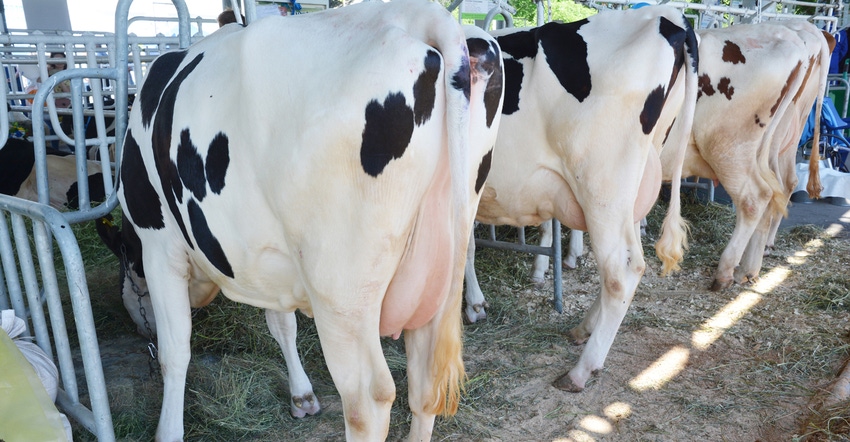
There are many factors that drive dairy profitability, from the price of milk to labor to many other things in between. But taking care of the “biologicals” first leads to financial success later, said Mike Lormore, head of the cattle technical services group at Zoetis.
In 2014, Lormore and others started a multiyear study to look at the top biological factors driving financial performance on dairy farms. Compeer Financial provided herd data going back to 2006 from farms in Minnesota, Wisconsin, South Dakota, Michigan and Ohio. This included data from 110 farms with an average herd size of 1,165 lactating cows.
The researchers then performed a regression analysis to see what factors correlated most to net farm income — measured on a per-hundredweight basis. More than 90 factors were considered. They were boiled down to the top 10 factors that, at least statistically, strongly correlated to net farm income, either positive or negative.
The top positive correlation: energy-corrected milk production.
The top negative correlation: net herd turnover costs.
But one factor, even though it statistically isn’t the most costly, correlates to everything else the most: somatic cell count.
“I like SCC. If I was going onto a dairy and I had to ask only one question, I would ask the bulk tank cell count,” said Lormore, speaking during the virtual Pennsylvania Dairy Summit. Based on that number, Lormore said that he can easily calculate losses, turnover and overall herd health on a dairy.
“What we sell is milk. We need to continue to invest in the highest-quality milk we can,” he said.
Big differences in NFI
The average net farm income per hundredweight — calculated by taking farm receipts and subtracting the sum of expenses and depreciation — was just 81 cents over the period, but it varied widely depending on year and farm, from negative $8 per cwt to $12.28 per cwt.
Profitability was cyclical, too. From 2010 to 2014, overall net farm income was positive, averaging $3.89 at its highest point in 2014. Then the market went bust. From 2015 to 2018, net farm income ranged from negative 15 cents down to negative $1.10. In fact, in 2018, no farm that contributed to the dataset made money, Lormore said.
During the most profitable years of 2017, 2011 and 2014, milk costs and production trended higher, feed costs trended lower, and somatic cell counts trended lower. The opposite was true of the least profitable years of 2006, 2009 and between 2015 and 2018: Milk costs and production trended lower, but feed costs and somatic cell counts trended higher.
But the study didn’t consider other possible factors that could’ve made an impact.
“Not everybody lives in the same regions, not every marketing order is the same, not everyone has the same land, same weather, same access to personnel, same access to capital,” Lormore said. “So it's about doing the best you can within the rules.”
Closer look at factors
There were big differences when looking at top-performing and bottom-performing farms and how individual factors affected those operations.
None was greater than net herd turnover costs where the difference in profit between the highest-performing and lowest-performing farms was $401,000 a year.
Many factors contribute to this, Lormore said, including the fact that younger cows produce less milk and there often are higher total replacement expenses on farms with higher net herd turnover costs. On average, the highest-performing farms produced 87.8 pounds of milk per head a day, while the lowest-performing farms produced 78.1 pounds per head a day.
High somatic cell counts and culling also correlated strongly with high net herd turnover costs.
Somatic cell counts had a big impact on net farm income. The difference in profit between farms with lower SCCs and higher SCCs was $263,000 a year. High SCCs correlated with a high percentage of death and days open.
Of course, more milk production means better profits, and higher net farm income. The difference in profit between higher-producing and lower-producing farms was $237,000 a year, with the highest-producing farms averaging 92.9 pounds of milk per head a day, and the lowest-producing farms averaging 73.7 pounds of milk per head a day.
Higher production correlates strongly to better breeding, which usually means bigger investments in genetics, as well as higher pregnancy rates.
Biologicals first, profits later
While the study is a small sample of the overall dairy industry, Lormore said it’s a good representation of what’s happening nationwide, as dairies grow larger and realize the advantages of economy of scale.
For example, this was the first year that labor cost came in as a top-10 factor in net farm income, he said, as operations with more experienced workers and better training are able to better control their per-hundredweight costs because they can dilute their costs by just producing more milk.
“Economies of size and scale are now being more effectively realized as management systems on larger farms, and as cows mature and cow populations stabilize," Lormore said. “And the managers are starting to generate opportunities now.”
The biggest takeaway for Lormore, though, is the fact that increased profitability starts first with healthy, well-tended cows.
“Husbandry is a really important driver of farm profitability,” he said. “If you're going to do it, you have to do it and do it well.”
About the Author(s)
You May Also Like






